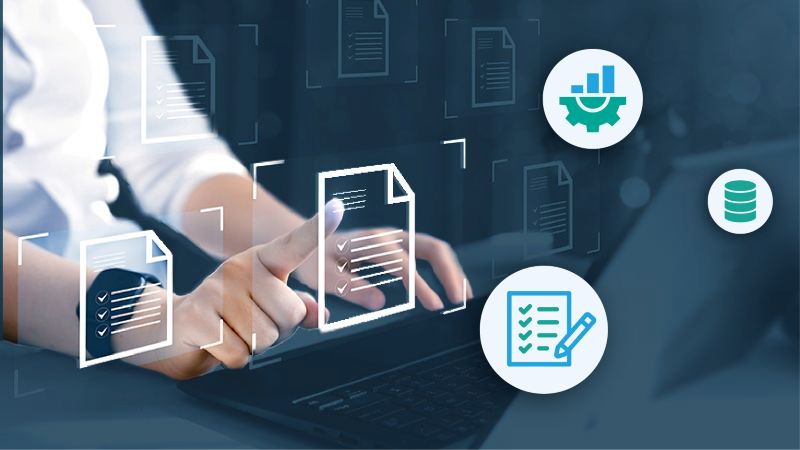While MDM certainly provides quality trusted data, stopping at that achievement severely impedes the realization of MDM’s full business value, and can prevent digital business transformation.
Many organizations view their investment in MDM as simply a way to consolidate and maintain their legacy batch ETL processes in support of their analytics platforms. Viewing this as the end-state of MDM denies its true potential value to the business.
Join Bill O’Kane, former Gartner VP and MDM Analyst and now Profisee VP & MDM Strategist to discover how to fully exploit the integration capabilities of MDM to create a technical and business environment conducive to digital business transformation.
Specifically, you will learn:
- What: Identify the capabilities of MDM that are often overlooked due to perceived technical complexity or lack of business vision.
- Why: Constraining MDM to the role of enforcing data quality for batch ETL processes in support of analytics prevents the business from achieving full value.
- How: To think about the power of MDM’s real-time integration capabilities, and how to describe and sell the outcomes they enable to business stakeholders.
Listen to the Podcast!
<
Myths Around Master Data Management
Bill starts off this session discussing the series we’ve been doing on the myths surrounding master data management. This session is on the myth that master data management is only about data quality. We are taking a little bit more simplistic view in this session to explain some of the MDM framework of what the capabilitiesare and where do people stop in their implementation life cycle. It’s important to understand why companies stop, and finally how do you take action to realize the full value of the master data management lifestyle in an organization.
Bill kicks off this session by reviewing this MDM framework of the 4 components or capabilities of MDM.
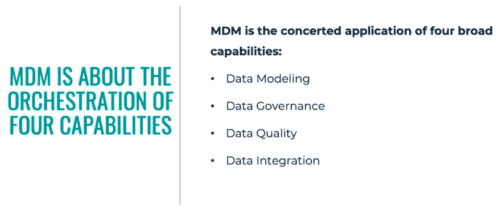
And when you see these areas documented, it helps inform why companies buy MDM software, really. You want all this functionality in one ‘box’ from one vendor vs trying to ‘cobble together’ a mishmash of 3-4 tools to try to do the same thing. Each of these capabilities is important and together make up the complete picture of master data management and realizing its full value. Where it all comes together for the most successful projects is when all four components are in play; that is when you see real digital transformation happen within a company.

So how does MDM integration enable digital transformation? In these three major ways:
- enables the increased value of your analytics
- makes operational MDM possible and requires the integration piece to be effective
- enables business benefits that both save money and make money
It makes sense really when you think about it – more timely trusted data means you can make better decisions. As well you can operationalize processes and optimize functions across the entire business when you are working with clean, trusted, and timely data.
Talking to the Business
So the next step is to start having conversations within the business group to really help them using their own language to come up with the problems they need help solving that good, clean trusted data will help them solve.
One of the first areas to address is actually within the IT department and it is helping them understand the cost component to batch data processing. You want them to see real bottom-line savings on moving to real-time data integration.
An obvious second area to talk to the business is anyone that is using dashboards and analytics. There really aren’t many groups that are ok with bad dashboards.
A third area to talk about with the business is in terms of thinking about how MDM can help them is have them think about any business processes that are driven by reaction to a report. So for example in customer onboarding, the agent is gathering information about the client and in 5 days, there is a report that shows a flag to some of the information that helps identify they are a good candidate for additional software for fraud risk as an example. Well, wouldn’t it be great to provide that real-time data that shows those flags while the agent is still on the phone with the new client rather than trying to get someone else to ring a week later and perhaps now the new client is busy with other tasks and you’ve missed an up-sell opportunity? It’s a chance, an opportunity to be proactive rather than reactive to the customer. This should be a major goal for companies and MDM directly allows you to drive revenue and decrease costs with an effective data integration strategy.
And a fourth area related to business processes but thinking of how can you create a new (unlike above where really you are revising an existing) business process supported by real-time data integration; perhaps it is related to getting a less expensive resource to do some of the initial upselling information gatherings and a more experienced say credit risk manager can then come behind and work through the more complicated new potential deals. It is looking at can we transform the way we manage and handle the customer onboarding process to reduce costs while looking for revenue upside.
Bill share’s this graphic which helps you visualize the four components he discussed above:
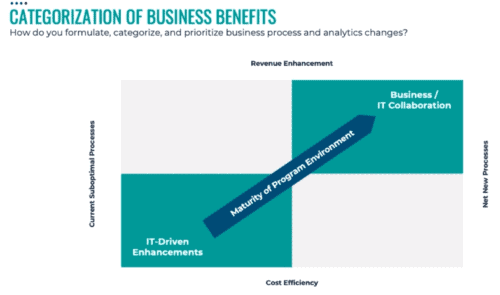
This helps you see you don’t want to get stuck in the lower left quadrant and only focused on IT enhancements, but how can you use the MDM program to drive improved business outcomes. You will hear Bill talk about looking for ‘above the line’ or making money impacts as well as ‘below the line’ or saving money impacts. He emphasizes it’s not even talking to the business about data per se but talking to them about what is not working and seeing how the MDM program could make improvements.
Back on the more technical side of making real-time integration a reality, Bill discusses how the integration works as a function of the different MDM implementation styles as seen below:
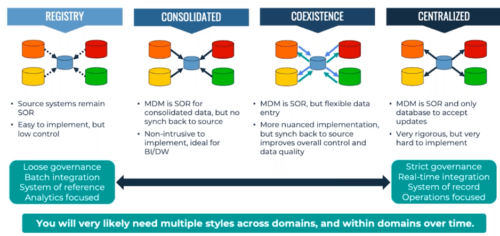
You won’t be sharing this with the business; this is really for your benefit on the IT side, but it’s good to see and understand more about the role integration plays as a key capability within the MDM capability framework we share at the beginning of this post.
At 20:38 – there is an excellent piece of the presentation where Bill discusses in more detail this disciplined approach with selecting the best implementation style for your MDM program based on a real-world data integration example.
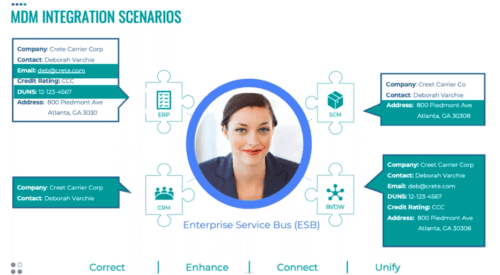
In summary, Bill focused in this session on data quality and that it is absolutely a key component of MDM capabilities but it certainly isn’t the only thing. An effective master data program really becomes powerful with data integration capabilities but really it needs all these pieces:
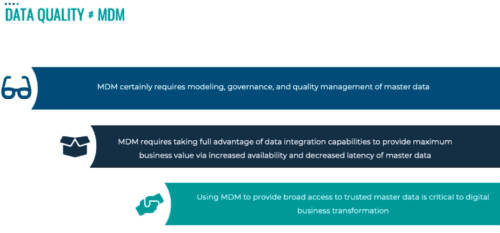
In order for MDM to drive the most business benefits for your company, you need to have data modeling, governance, and quality capabilities. Where the program can jump up to the next level and for the most benefit, you need to take advantage of data integration capabilities. Using MDM to provide broad access to clean, trusted master data is the key to a successful digital transformation.
Q&A
Benefits of Data Governance with MDM without Implementing a New System
You can still get the same benefits even if you aren’t moving data into a new system, by taking the same approach against data in your source systems. Most source system data is not of the highest quality and so can absolutely be improved upon following the data governance approach.
Using the data maturity model, what is the minimum level you should be at when you add data governance into your MDM project?
You want to be at least at the proactive stage – that is ideal. However, the faster you can move on from the awareness phase and get started the better. Remember, when is the best time to start data governance – today – if it’s not already in place!
How senior should the data owners be?
As senior as possible while balancing the realistic work required against the timelines of your project. They will need the budget, authority, and resources to make decisions & changes to the data.
Best practics for DG SLAs.
Nicola doesn’t typically put in SLAs in place for data governance but more around the MDM system: adding fields, deleting fields, response times, resolution times, or turn around time on data definition reviews. Data governance is more a cultural change and framework implementation that takes time versus using SLAs on the mechanics of how the system is functioning.
What is the difference between data stewardship and data governance?
Data stewardship is part of data governance. Data stewardship/data ownership are part of the roles/responsibilities within the data governance framework.
What are some of the mistakes that companies make?
Doing it from IT, should be business-led; and another common one – misalignment with corporate strategy.
Quick Wins for Data Governance
Eliminate manual data processes or workarounds due to bad data quality.
Look for the team that does customer complaints – focus on rework or issues caused by bad data – wrong addresses, missed shipments.
What are some KPIs for Data Governance?
Some of the benefits aren’t seen until you do it. It is more focused on the progress made on the project vs value gained as at times it can be harder to quantify. Check out Profisee’s BIR program for how we help you calculate this value potential.
Roles – Data Owners vs Data Stewards – what is the difference?
Data owners are the most senior role within the organization that has the budget, authority, and resources to make decisions & changes to the data. That being said, on a day to day basis, they will typically appoint a data steward from their organization to actually do the work that needs to be done with the subject matter expertise on the data. So typically a data steward will write up data definitions and give them to the data owner for approval, or perhaps document the rules around acceptance for data quality with the approval of the data owner.
In summary, we reviewed:
Building a trusted data foundation is at the core of what every business must strive for today. This foundation is the strongest it can be when companies take the time to make data governance a part of their MDM project. DG and MDM – better together.

Bill O'Kane
A former Gartner analyst, Bill O'Kane was the VP & MDM Strategist at Profisee.








